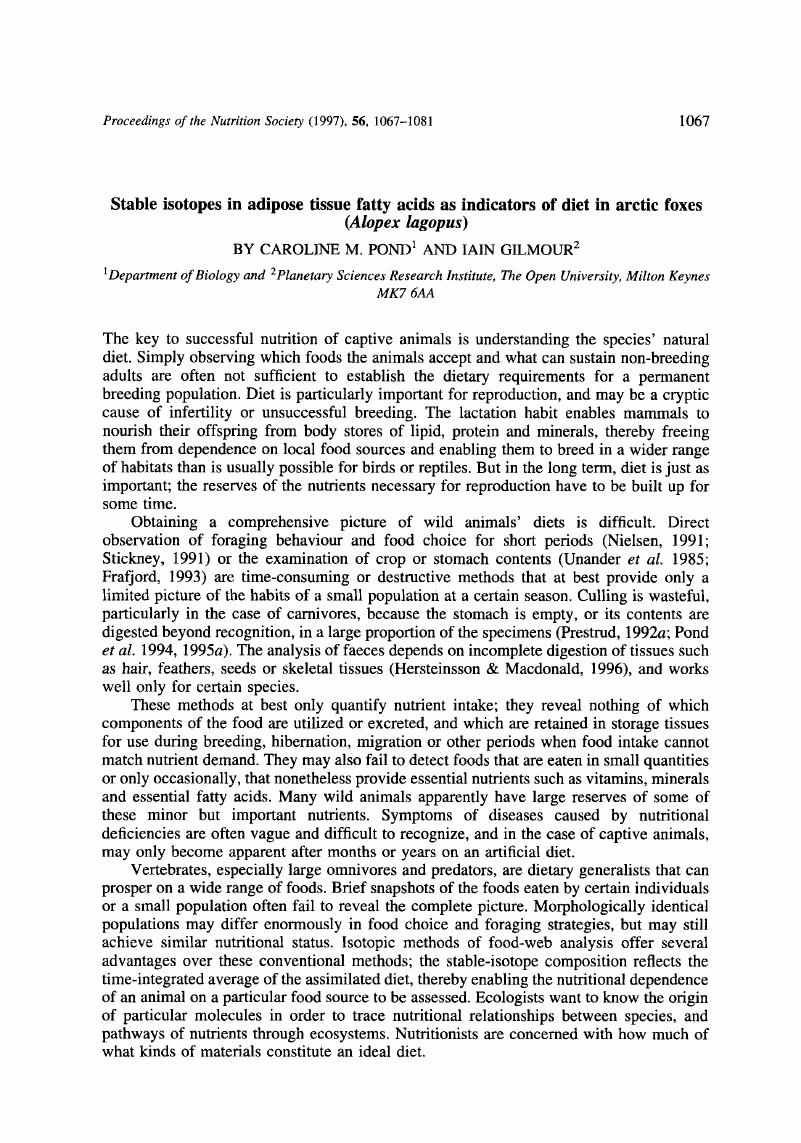Crossref Citations
This article has been cited by the following publications. This list is generated based on data provided by Crossref.
Pond, Caroline
2001.
Encyclopedia of Life Sciences.
Pond, Caroline M.
2003.
Encyclopedia of Biodiversity.
p.
495.
Jim, Susan
Ambrose, Stanley H.
and
Evershed, Richard P.
2003.
Natural abundance stable carbon isotope evidence for the routing and de novo synthesis of bone FA and cholesterol.
Lipids,
Vol. 38,
Issue. 2,
p.
179.
Fuglei, E.
Bustnes, J.O.
Hop, H.
Mørk, T.
Björnfoth, H.
and
van Bavel, B.
2007.
Environmental contaminants in arctic foxes (Alopex lagopus) in Svalbard: Relationships with feeding ecology and body condition.
Environmental Pollution,
Vol. 146,
Issue. 1,
p.
128.
Bentzen, T.W.
Follmann, E.H.
Amstrup, S.C.
York, G.S.
Wooller, M.J.
and
O’Hara, T.M.
2007.
Variation in winter diet of southern Beaufort Sea polar bears inferred from stable isotope analysis.
Canadian Journal of Zoology,
Vol. 85,
Issue. 5,
p.
596.
Bentzen, T. W.
Follmann, E. H.
Amstrup, S. C.
York, G. S.
Wooller, M. J.
Muir, D. C.G.
and
O’Hara, T. M.
2008.
Dietary biomagnification of organochlorine contaminants in Alaskan polar bears.
Canadian Journal of Zoology,
Vol. 86,
Issue. 3,
p.
177.
Owen, Ellie
Daunt, Francis
and
Wanless, Sarah
2010.
Sampling avian adipose tissue: assessing a nondestructive biopsy technique.
Journal of Field Ornithology,
Vol. 81,
Issue. 1,
p.
92.
Pond, Caroline M
2011.
Encyclopedia of Life Sciences.
Richter, E. K.
Spangenberg, J. E.
Willems, H.
Kreuzer, M.
and
Leiber, F.
2012.
Stable carbon isotope composition of perirenal adipose tissue fatty acids from Engadine sheep grazing either mountain or lowland pasture1.
Journal of Animal Science,
Vol. 90,
Issue. 3,
p.
905.
Richter, Eva Katharina
Spangenberg, Jorge E.
Klevenhusen, Fenja
Soliva, Carla R.
Kreuzer, Michael
and
Leiber, Florian
2012.
Stable Carbon Isotope Composition of c9,t11‐Conjugated Linoleic Acid in Cow's Milk as Related to Dietary Fatty Acids.
Lipids,
Vol. 47,
Issue. 2,
p.
161.
Pond, Caroline M.
2013.
Encyclopedia of Biodiversity.
p.
23.
Bentzen, Rebecca
Castellini, J. Margaret
Gerlach, Robert
Dykstra, Claude
and
O'Hara, Todd
2016.
Mercury concentrations in Alaska Pacific halibut muscle relative to stable isotopes of C and N and other biological variables.
Marine Pollution Bulletin,
Vol. 113,
Issue. 1-2,
p.
110.
Hallanger, Ingeborg G.
Fuglei, Eva
Yoccoz, Nigel G.
Pedersen, Åshild Ø.
König, Max
and
Routti, Heli
2019.
Temporal trend of mercury in relation to feeding habits and food availability in arctic foxes (Vulpes lagopus) from Svalbard, Norway.
Science of The Total Environment,
Vol. 670,
Issue. ,
p.
1125.
Hallanger, Ingeborg G.
Ask, Amalie
and
Fuglei, Eva
2022.
Occurrence of ingested human litter in winter arctic foxes (Vulpes lagopus) from Svalbard, Norway.
Environmental Pollution,
Vol. 303,
Issue. ,
p.
119099.





